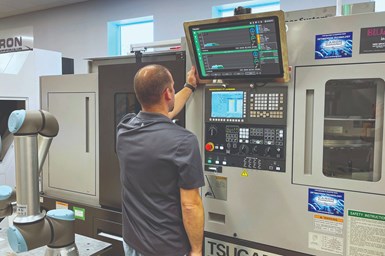Taking Someone to TASC
This special automation issue of Production Machining is timed perfectly with the debut of The Automated Shop Conference held this month in Novi, Michigan.

Automation is more than robots. For example, at TASC, Rob Caron, president of Caron Engineering, will address in his session how various smart technology systems can help shops automate each step of the manufacturing process. In fact, I recently wrote an article explaining the advantages of his company’s adaptive machining technology and how automatically monitoring and adjusting cutting parameters inside a machine while checking for tool wear is just as important to establishing a reliable lights-out machining process as having a robot outside the machine. Learn more at gbm.media/adaptive-922. (Photo credit: Caron Engineering)
I’ve mentioned before that, like other publications, Production Machining puts together an annual editorial calendar to ensure we cover a range of topics, technology and processes relevant to machine shops such as yours. My goal for this October issue was to have an automation theme. That we achieved — given that the four feature articles and three Tech Briefs all touch on some form of automated process, some involving robots and some not (automation is more than robots).
Examples include automated machine tool tending, flexible manufacturing systems, CMM inspection, shopfloor gaging and cutting fluid management. All of these concepts can be applied in shops such as yours today.
This issue pairs nicely with the debut of The Automated Shop Conference (TASC) held October 10-11 at the Suburban Collection Showplace in Novi, Michigan. In short, TASC (tascevent.com) was created to provide key insights and practical guidance to machine shops of all sizes searching for automation solutions.
The event cochairs are Brent Donaldson, Modern Machine Shop’s editor-in-chief, and Matt Kirchner, president of LAB Midwest (and also contributing About Your Business columnist for Production Machining).
I asked both to comment on the inaugural event. “Through Modern Machine Shop’s Top Shops benchmarking data, we already know that this country’s top performing small- and mid-sized shops are automating, although in some cases not at the same levels as larger shops,” Donaldson explains. “What’s more clear is that higher levels of automation are associated with higher performance.”
Kirchner says “Automation is totally transforming the machining industry. Especially for high-volume machining — high mix or low mix — automation will be a necessity to remain competitive the future. World-class machining operations that invest in automated machine tending, robotic metrology, automated inspection, end-of-arm 3D scanning and the like will gain a huge competitive cost and quality advantage over those that don’t. The beauty of TASC is that its focus is on these specific advancements and technologies.”
For automation to succeed, it has to become part of your company’s DNA.
Sessions during the two-day event will cover a range of topics and kicks off with a keynote from Kirchner offering insight about preparing your shop for automation and making it a part of your culture. This is important because for automation to succeed, much like lean manufacturing, it has to become part of your company’s DNA.
So, consider attending and also taking someone to TASC with you. But, don’t take me to task if you encounter the words automate and automation quite a bit in this issue. It’s by design.
Related Content
Automation Idea for Halloween?
Maybe not. But, the candy-throwing robots at MetalQuest’s Nebraska facility do enable the contract machine shop to stand out at career fairs and similar events.
Read MoreHolding Aerospace Tolerances 24/7 in Central Wisconsin
Exceedingly challenging machining applications have a way of becoming achievable with the right team and equipment. Pointe Precision offers a case in point with its new automated fuel metering valve grinding and measurement cells.
Read MorePredicting the ROI of Robotic Automation
Various methodologies paired with online tools can help small to mid-sized manufacturers determine how to predict and calculate the potential economic benefits of robotic equipment for their specific needs.
Read MoreAutomation Breakthroughs Revolutionize Precision Machining for Complex Parts
Marubeni Citizen-Cincom delivers custom solutions to address some of the biggest challenges in precision machining from handling small parts, to robot integration and unique tooling needs.
Read MoreRead Next
Finding the Right Tools for a Turning Shop
Xcelicut is a startup shop that has grown thanks to the right machines, cutting tools, grants and other resources.
Read MoreHow To (Better) Make a Micrometer
How does an inspection equipment manufacturer organize its factory floor? Join us as we explore the continuous improvement strategies and culture shifts The L.S. Starrett Co. is implementing across the over 500,000 square feet of its Athol, Massachusetts, headquarters.
Read More




















